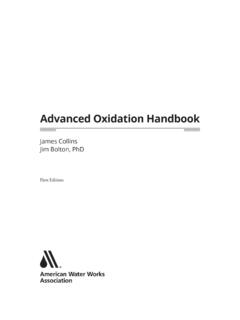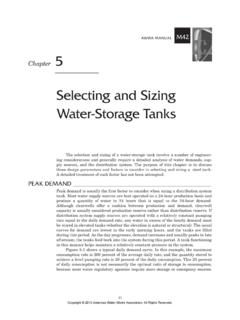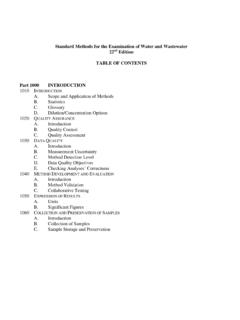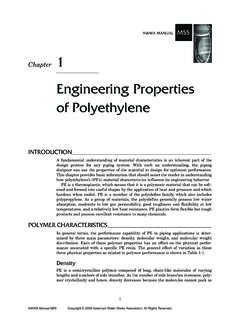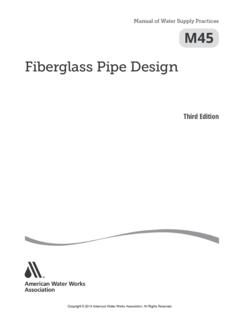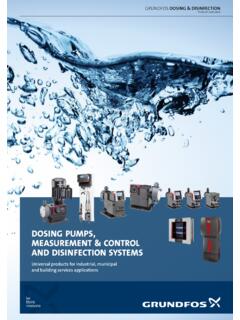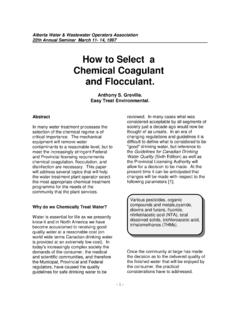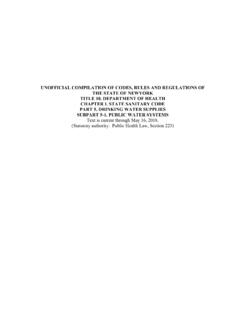Transcription of Iron and Manganese Removal - American Water Works …
1 Iron and Manganese Removal HandbookSecond EditionEXCERPT354 Overview of treatment TechnologiesSeveral treatment methods may be used to remove iron and Manganese from drinking Water supplies. This chapter provides an overview of treat - ment options that should be considered for iron and Manganese Removal and includes guidance regarding selection of treatment methods for a par-ticular the past decade or so, advances in treatment technologies have allowed systems to be constructed in less space, produce fewer residuals, and treat multiple chapter addresses two key questions:1. Why consider new technologies?2. When should traditional technologies be used?A few years ago, a utility discovered that a well with elevated iron (10 mg/L) and Manganese ( mg/L) also showed evidence of surface Water contamination.
2 Traditional treatment methods would have included the use of clarification, oxidation, coagulation, and filtration. Instead, the util-ity was able to use an ultrafiltration (UF) membrane to accomplish the Removal of the iron, Manganese , and pathogens. No clarification or coag-ulation was needed. The use of membranes was and in some cases still is considered to be an innovative treatment technology. The use of mem-branes resulted in significant savings for the owner. Figure 4-1 describes the traditional and newer technologies that can be used to remove iron and Iron and Manganese Removal Handbook Figure 4-1 SOURCE OF SUPPLY Well Reservoir Creek/RiverOXIDATION Aeration Chlorine (gas chlorine, sodium hypochlorite, calcium hypochlorite, on- site generation of sodium hypochlorite)
3 Potassium Permanganate Sodium Permanganate Chlorine Dioxide Ozone Ozone Biological FiltrationCLARIFICATION Conventional Sedimentation Plate Settlers Tube Settlers Ballasted FlocculationFILTRATION Dual Media Greensand Ion Exchange MnO2 Coated Media MnO2 Ore Hollow-Fiber Membranes Spiral Membranes Ceramic MembranesRESIDUALS Direct Discharge to Sewer Equalization and Sewer Lagoons and Sand Drying Beds Mechanical DewateringTechnologies for iron and Manganese removalSource: Hatch Mott MacDonaldEXCERPTO verview of treatment Technologies 37 OVERVIEW OF TECHNOLOGIESThe treatment for iron and Manganese typically involves multiple unit processes. The answer to the question When should traditional technolo-gies be used?
4 Can be found in the properties of iron and Manganese that are encountered in source discussed in chapter 1, iron and Manganese are often found in Water supplies in their dissolved state. Traditional technologies involve converting these dissolved forms to a particulate form that can be clarified and filtered. The conversion from dissolved to particulate forms requires the use of an oxidant. Traditional forms of oxidation are well understood and can be successfully sedimentation and filtration technologies are well suit-ed for the Removal of particulate forms of iron and Manganese . Traditional technologies are typically simple to operate and generally do not employ the use of proprietary treatment technologies may be beneficial for small sites or in situ-ations that have multiple contaminants.
5 Nontraditional technologies may warrant consideration for systems with the following conditions: High concentrations of radionuclides Wells under the influence of surface Water Wells with high iron/ Manganese and limited space Sites where disposal of residuals is problematic Sites where very high backwash volumes would impact Water productionThe nontraditional treatment methods for the Removal of iron and Manganese include the following: Ballasted flocculation Membrane filtrationBiological filtrationWhen selecting and designing a process for iron and Manganese treat - ment , the quality of the source Water should be analyzed comprehensively, because some contaminants can affect the operation of the system. For example, radiological contaminants may be removed by some types of filter media, but the media may become radioactive, resulting in safety concerns and increased cost for media disposal.
6 In most cases, separate treatment for radiological contaminants may result in a lower life-cycle Iron and Manganese Removal Handbook SEQUESTRATIONS equestration is a form of treatment in which a chemical, known as a sequestrant, is added to groundwater. The chemical forms a bond with iron and Manganese ions, allowing them to remain in solution. Seques-tration for drinking Water treatment of iron and Manganese is generally limited to sources where the iron is less than mg/L and the Manganese is less than mg/L. Sequestration of source Water concentrations above these values may result in aesthetic issues in the distribution system and is generally not allowed by , CLARIFICATION, FILTRATIONMost iron and Manganese Removal treatment processes incorporate oxida-tion to convert the dissolved forms of the metals to a solid, followed by a filtration process.
7 When concentrations in the source Water are above 8 to 10 mg/L combined iron and Manganese , a clarification step is typically required prior to filtration. A combined iron and Manganese concentration of 8 mg/L will generally result in a filter run time of less than 24 hours for sand/anthracite filters as well as greensand-type clarification process reduces the amount of solids that must be removed by the filters, which results in longer filter run times before back-washing is required. Clarification may be achieved using any number of technologies, such as conventional sedimentation, plate or tube settlers, solids-contact clarifiers, dissolved air flotation, or ballasted flocculation. The type of filtration used in this treatment approach may be a conven-tional dual-media anthracite-and-sand filter, a mono-medium sand or anthracite filter, glauconite, Manganese dioxide coated sand media, or Manganese dioxide , Manganese DIOXIDE COATED MEDIA FILTRATIONF iltration using Manganese dioxide coated and ore-type catalytic media, such as Manganese greensand, has historically been used for iron and man-ganese Removal .
8 In recent years advances have been made in the types of Manganese dioxide media, allowing for higher loading rates and reducing backwash different types of proprietary Manganese dioxide coated media filtration systems are available for iron and Manganese Removal . Although the mechanics vary, the basic treatment provided is oxidation of EXCERPTO verview of treatment Technologies 39iron and Manganese with the addition of chlorine or potassium permanga-nate followed by filtration of precipitates. Manganese dioxide coating on the filter media acts as a catalyst for the oxidation and reduction of iron and of the proprietary media on the market include the following: Ferrosand Manganese greensand produced by Hungerford and Te r r y GreensandPlusTM synthetic Manganese greensand produced by Hungerford & Terry LayneOxTM produced by Layne Christensen Company ANTHRA/SANDTM produced by WesTechThese media can be classified into two groups: Manganese dioxide coated sand and Manganese dioxide ore.
9 All these media are similar in that they use a combination of chemical oxidation and catalytic media to remove iron and Manganese in Water . Different proprietary media have different specific mechanics, loading rates, backwashing requirements, and Removal of the Manganese dioxide coated media systems is discussed in further detail in chapter , MEMBRANE FILTRATIONM embranes are often used for Removal of turbidity and pathogens from surface Water and groundwater under the direct influence (GUDI) of sur-face Water . Membranes are also used for iron and Manganese Removal . Membrane treatment is often a viable option for GUDI wells that require treatment for iron and Manganese . Membranes may be considered as a treatment option when the source Water is non-GUDI groundwater, but typically are not the most cost-effective treatment solution in this systems operate by straining out particles that are larger than the pore size of the membrane.
10 Microfilters are generally classified as having openings between and microns, whereas ultrafilters are generally classified as having openings between and microns. Dissolved iron and Manganese converted to particulate form via conven-tional oxidation can be subsequently strained out on the manufacturers of micro/ultrafilters have experience in treat -ing Water for iron and Manganese . Each system uses a unique membrane and operates slightly differently in terms of backwashing and cleaning. Pressurized and immersed membrane systems are Iron and Manganese Removal Handbook BIOLOGICAL FILTRATIONH ydraulically, the biological filtration process operates similarly to a pres-sure filter in that raw Water is pumped through a pressure vessel containing a granular media. However, unlike most other pressure filtration systems, which rely on the formation of a chemical precipitate and subsequent filtra-tion, biological processes do not require any chemical , conditions are established in the pressure vessel that foster the growth of bacteria.
